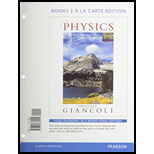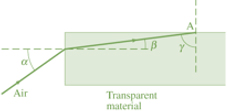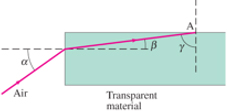
Physics: Principles with Applications, Books a la Carte Edition & Modified Mastering Physics with Pearson eText -- ValuePack Access Card Package
1st Edition
ISBN: 9780321974990
Author: Douglas C. Giancoli
Publisher: PEARSON
expand_more
expand_more
format_list_bulleted
Concept explainers
Question
Chapter 23, Problem 40P
To determine
The range of angle for which total internal reflection occurs at the side surface of the material (at point )when a beam of light enters the end of an optic fibre and its index of refraction is greater than .

To determine
(b)
The result when fiber were immersed in the water.

Expert Solution & Answer
Want to see the full answer?
Check out a sample textbook solution
Students have asked these similar questions
3.63 • Leaping the River II. A physics professor did daredevil
stunts in his spare time. His last stunt was an attempt to jump across
a river on a motorcycle (Fig. P3.63). The takeoff ramp was inclined at
53.0°, the river was 40.0 m wide, and the far bank was 15.0 m lower
than the top of the ramp. The river itself was 100 m below the ramp.
Ignore air resistance. (a) What should his speed have been at the top of
the ramp to have just made it to the edge of the far bank? (b) If his speed
was only half the value found in part (a), where did he land?
Figure P3.63
53.0°
100 m
40.0 m→
15.0 m
Please solve and answer the question correctly please. Thank you!!
You throw a small rock straight up from the edge of a highway bridge that crosses a river. The rock passes you on its way down, 5.00 s after it was thrown. What is the speed of the rock just before it reaches the water 25.0 m below the point where the rock left your hand? Ignore air resistance.
Chapter 23 Solutions
Physics: Principles with Applications, Books a la Carte Edition & Modified Mastering Physics with Pearson eText -- ValuePack Access Card Package
Ch. 23 - Prob. 1OQCh. 23 - Prob. 2OQCh. 23 - Prob. 1QCh. 23 - What is the focal length of a plane mirror? What...Ch. 23 - Prob. 3QCh. 23 - Prob. 4QCh. 23 - Prob. 5QCh. 23 - Prob. 6QCh. 23 - Prob. 7QCh. 23 - Prob. 8Q
Ch. 23 - Prob. 9QCh. 23 - Prob. 10QCh. 23 - Prob. 11QCh. 23 - You look into an aquarium and view a fish inside....Ch. 23 - Prob. 13QCh. 23 - Prob. 14QCh. 23 - A child looks into a pool to see how deep it is....Ch. 23 - Prob. 16QCh. 23 - Prob. 17QCh. 23 - Prob. 18QCh. 23 - Prob. 19QCh. 23 - Prob. 20QCh. 23 - Prob. 21QCh. 23 - Prob. 22QCh. 23 - Prob. 23QCh. 23 - Prob. 24QCh. 23 - Prob. 25QCh. 23 - Prob. 26QCh. 23 - Prob. 27QCh. 23 - Prob. 28QCh. 23 - Prob. 29QCh. 23 - Prob. 30QCh. 23 - Prob. 31QCh. 23 - Prob. 32QCh. 23 - Prob. 1MCQCh. 23 - Prob. 2MCQCh. 23 - Prob. 3MCQCh. 23 - Prob. 4MCQCh. 23 - Prob. 5MCQCh. 23 - Prob. 6MCQCh. 23 - Prob. 7MCQCh. 23 - Prob. 8MCQCh. 23 - Prob. 9MCQCh. 23 - Prob. 10MCQCh. 23 - Prob. 11MCQCh. 23 - Prob. 12MCQCh. 23 - Prob. 13MCQCh. 23 - Prob. 14MCQCh. 23 - Prob. 1PCh. 23 - Prob. 2PCh. 23 - Two plane mirrors meet at a 1350 angle, Fig....Ch. 23 - Prob. 4PCh. 23 - Prob. 5PCh. 23 - Prob. 6PCh. 23 - Suppose you are 94 cm from a plane mirror. What...Ch. 23 - A solar cooker, really a concave mirror pointed at...Ch. 23 - How far from a concave mirror (radius 21.0 cm)...Ch. 23 - A small candle is 38 cm from a concave mirror...Ch. 23 - An object 3.0 mm high is placed 16 cm from a...Ch. 23 - A dentist wants a small mirror that, when 2.00 cm...Ch. 23 - You are standing 3.4 m from a convex security...Ch. 23 - The image of a distant tree is virtual and very...Ch. 23 - Prob. 15PCh. 23 - Prob. 16PCh. 23 - Prob. 17PCh. 23 - Some rearview mirrors produce images of cars to...Ch. 23 - Prob. 19PCh. 23 - Prob. 20PCh. 23 - Prob. 21PCh. 23 - Prob. 22PCh. 23 - Prob. 23PCh. 23 - Prob. 24PCh. 23 - Prob. 25PCh. 23 - Prob. 26PCh. 23 - Prob. 27PCh. 23 - Prob. 28PCh. 23 - Prob. 29PCh. 23 - Prob. 30PCh. 23 - Rays of the Sunare seen to make a 36.0° angle to...Ch. 23 - Prob. 32PCh. 23 - A beam of light in air strikes a slab of glass (n...Ch. 23 - Prob. 34PCh. 23 - Prob. 35PCh. 23 - Prob. 36PCh. 23 - Prob. 37PCh. 23 - Prob. 38PCh. 23 - 39. (Ill) (a) What is the minimum index of...Ch. 23 - 40. (Ill) A beam of light enters the end of an...Ch. 23 - Prob. 41PCh. 23 - Prob. 42PCh. 23 - Prob. 43PCh. 23 - Prob. 44PCh. 23 - Prob. 45PCh. 23 - Prob. 46PCh. 23 - A stamp collector uses a converging lens with...Ch. 23 - Prob. 48PCh. 23 - Prob. 49PCh. 23 - Prob. 50PCh. 23 - Prob. 51PCh. 23 - Prob. 52PCh. 23 - Prob. 53PCh. 23 - Prob. 54PCh. 23 - Prob. 55PCh. 23 - Prob. 56PCh. 23 - Prob. 57PCh. 23 - A diverging lens with f= -36.5 cm is placed 14.0...Ch. 23 - Prob. 59PCh. 23 - Prob. 60PCh. 23 - Two lenses, one converging with focal length 20.0...Ch. 23 - Prob. 62PCh. 23 - A double concave lens has surface radii of 33.4 cm...Ch. 23 - Prob. 64PCh. 23 - Prob. 65PCh. 23 - Prob. 66PCh. 23 - Prob. 67PCh. 23 - Prob. 68PCh. 23 - Prob. 69GPCh. 23 - Prob. 70GPCh. 23 - Prob. 71GPCh. 23 - The critical angle of a certain piece of plastic...Ch. 23 - Prob. 73GPCh. 23 - Prob. 74GPCh. 23 - Prob. 75GPCh. 23 - Prob. 76GPCh. 23 - 77
77. If the apex of a prism is ? = 75o (see...Ch. 23 - Prob. 78GPCh. 23 - Prob. 79GPCh. 23 - Prob. 80GPCh. 23 - Prob. 81GPCh. 23 - Prob. 82GPCh. 23 - Prob. 83GPCh. 23 - Figure 23-65is a photograph of an eyeball with the...Ch. 23 - Prob. 85GPCh. 23 - Prob. 86GPCh. 23 - 87 ‘(a) Show that if two thin lenses of focal...Ch. 23 - Prob. 88GPCh. 23 - Prob. 89GPCh. 23 - Prob. 90GP
Additional Science Textbook Solutions
Find more solutions based on key concepts
Fibrous connective tissue consists of ground substance and fibers that provide strength, support, and flexibili...
Human Biology: Concepts and Current Issues (8th Edition)
Pigeons may exhibit a checkered or plain color pattern. In a series of controlled matings, the following data w...
Concepts of Genetics (12th Edition)
Choose the best answer to each of the following. Explain your reasoning. Which of the following was not a major...
Cosmic Perspective Fundamentals
6. A particle starts from x0 = 10 m at t = 0 s and moves with the velocity graph shown in FIGURE EX2.6.
a. Do...
Physics for Scientists and Engineers: A Strategic Approach, Vol. 1 (Chs 1-21) (4th Edition)
Identify each of the following characteristics as belonging to cervical, thoracic, or lumbar vertebrae; the sac...
Human Anatomy & Physiology (2nd Edition)
WRITE ABOUT A THEME: INTERACTIONS In a short essay (100-150 words), identify the factor or factors in Figure 53...
Campbell Biology (11th Edition)
Knowledge Booster
Learn more about
Need a deep-dive on the concept behind this application? Look no further. Learn more about this topic, physics and related others by exploring similar questions and additional content below.Similar questions
- Help me make a visualize experimental setup using a word document. For the theory below.arrow_forwardHow to solve this, given answerarrow_forwardThree point-like charges are placed at the corners of a square as shown in the figure, 28.0 cm on each side. Find the minimum amount of work required by an external force to move the charge q1 to infinity. Let q1=-2.10 μC, q2=+2.40 μС, q3=+3.60 μC.arrow_forward
- A point charge of -4.00 nC is at the origin, and a second point charge of 6.00 nC is on the x axis at x= 0.820 mm . Find the magnitude and direction of the electric field at each of the following points on the x axis. x2 = 19.0 cmarrow_forwardFour point-like charges are placed as shown in the figure, three of them are at the corners and one at the center of a square, 36.0 cm on each side. What is the electric potential at the empty corner? Let q1=q3=+26.0 µС, q2=-28.0 μC, and q4=-48.0μc Varrow_forwardPLS HELparrow_forward
arrow_back_ios
SEE MORE QUESTIONS
arrow_forward_ios
Recommended textbooks for you
 College PhysicsPhysicsISBN:9781305952300Author:Raymond A. Serway, Chris VuillePublisher:Cengage Learning
College PhysicsPhysicsISBN:9781305952300Author:Raymond A. Serway, Chris VuillePublisher:Cengage Learning University Physics (14th Edition)PhysicsISBN:9780133969290Author:Hugh D. Young, Roger A. FreedmanPublisher:PEARSON
University Physics (14th Edition)PhysicsISBN:9780133969290Author:Hugh D. Young, Roger A. FreedmanPublisher:PEARSON Introduction To Quantum MechanicsPhysicsISBN:9781107189638Author:Griffiths, David J., Schroeter, Darrell F.Publisher:Cambridge University Press
Introduction To Quantum MechanicsPhysicsISBN:9781107189638Author:Griffiths, David J., Schroeter, Darrell F.Publisher:Cambridge University Press Physics for Scientists and EngineersPhysicsISBN:9781337553278Author:Raymond A. Serway, John W. JewettPublisher:Cengage Learning
Physics for Scientists and EngineersPhysicsISBN:9781337553278Author:Raymond A. Serway, John W. JewettPublisher:Cengage Learning Lecture- Tutorials for Introductory AstronomyPhysicsISBN:9780321820464Author:Edward E. Prather, Tim P. Slater, Jeff P. Adams, Gina BrissendenPublisher:Addison-Wesley
Lecture- Tutorials for Introductory AstronomyPhysicsISBN:9780321820464Author:Edward E. Prather, Tim P. Slater, Jeff P. Adams, Gina BrissendenPublisher:Addison-Wesley College Physics: A Strategic Approach (4th Editio...PhysicsISBN:9780134609034Author:Randall D. Knight (Professor Emeritus), Brian Jones, Stuart FieldPublisher:PEARSON
College Physics: A Strategic Approach (4th Editio...PhysicsISBN:9780134609034Author:Randall D. Knight (Professor Emeritus), Brian Jones, Stuart FieldPublisher:PEARSON

College Physics
Physics
ISBN:9781305952300
Author:Raymond A. Serway, Chris Vuille
Publisher:Cengage Learning

University Physics (14th Edition)
Physics
ISBN:9780133969290
Author:Hugh D. Young, Roger A. Freedman
Publisher:PEARSON

Introduction To Quantum Mechanics
Physics
ISBN:9781107189638
Author:Griffiths, David J., Schroeter, Darrell F.
Publisher:Cambridge University Press

Physics for Scientists and Engineers
Physics
ISBN:9781337553278
Author:Raymond A. Serway, John W. Jewett
Publisher:Cengage Learning

Lecture- Tutorials for Introductory Astronomy
Physics
ISBN:9780321820464
Author:Edward E. Prather, Tim P. Slater, Jeff P. Adams, Gina Brissenden
Publisher:Addison-Wesley

College Physics: A Strategic Approach (4th Editio...
Physics
ISBN:9780134609034
Author:Randall D. Knight (Professor Emeritus), Brian Jones, Stuart Field
Publisher:PEARSON
Convex and Concave Lenses; Author: Manocha Academy;https://www.youtube.com/watch?v=CJ6aB5ULqa0;License: Standard YouTube License, CC-BY